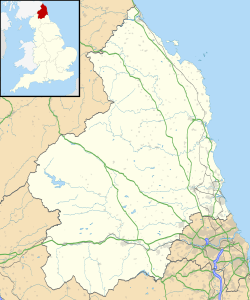Habitancum facts for kids
Quick facts for kids Habitancum |
|
|---|---|

Site of Habitancum Roman Fort
|
|
| Location | |
| Coordinates | 55°10′12″N 2°10′19″W / 55.170°N 2.172°W |
| Place name | Risingham |
| County | Northumberland |
| Country | England |
| Reference | |
| UK-OSNG reference | NY891861 |
Habitancum was an ancient Roman fort. It was located at Risingham in Northumberland, England. This fort was one of many strongholds. They were built along Dere Street, an important Roman road. Dere Street stretched from York all the way to Melrose.
The fort's name, Habitancum, comes from an altar found there. An altar is a stone monument. It was set up by a Roman official named Marcus Gavius Secundinus. This fort is not mentioned in other old Roman records.
Contents
Where Was Habitancum Located?
The fort is about 13 miles (21 km) north of Corbridge. Corbridge was another important Roman site. It is also 8 miles (13 km) south of Bremenium, the next Roman fort. Habitancum sits west of the A68 road. This road runs between Corbridge and Jedburgh. The fort is near where the road crosses the River Rede. This crossing point is at the village of West Woodburn.
What Did the Fort Look Like?
The fort sits on a low hill. It overlooks the River Rede. The fort was shaped like an oblong, which means it was longer than it was wide. It measured about 450 feet (137 meters) from north to south. It was 400 feet (122 meters) from east to west. This gave it an area of just over 4 acres (1.6 hectares).
The fort was protected by several ditches. You can still see these ditches today. They are visible on the south and west sides of the fort.
Fort Walls and Gates
Habitancum had gates in its south and west walls. It's possible there were other gates, but no evidence has been found. The fort's walls were made of sandstone blocks. Behind these stone walls was a thick clay bank. This bank was about thirty feet (9 meters) thick.
Around the end of the 2nd century, the fort faced trouble. Many Roman troops were pulled away from the area. Because of this, the fort was either left empty or destroyed. Later, a group of soldiers called the First Cohort of Vangiones rebuilt the fort. This group was very large, with about one thousand soldiers.
Who Guarded the Fort?
We are not entirely sure which soldiers guarded Habitancum in the 2nd century. It might have been a group called Cohors IV Gallorum equitata. This was a cavalry unit.
In the 3rd century, we know more about the garrison. The main group was the First Cohort of Vangiones. A "cohort" was a large group of Roman soldiers. There was also a "Numerus Exploratorum," which means a unit of scouts. Plus, a detachment of "Raeti Gaesati" were present. These were pikemen, soldiers who used long spears.
What Can You See Today?
Today, only a few stone remains are visible. You can see them at the north-eastern corner of the fort. However, if you look closely, you can make out the shapes of old buildings. These outlines are beneath the grass inside the fort. You can also clearly see the ditches that surrounded the fort on all sides.


